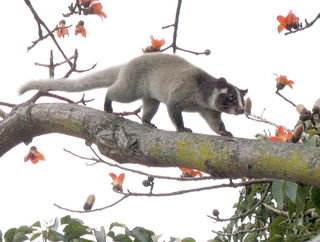
Original source: Balance beam
Author: Denise Chan from Hong Kong, China
Masked palm civet
Order : Carnivora
Family : Viverridae
Subfamily : Paradoxurinae
Species : Paguma larvata
The Gem-faced civet, masked palm civet is listed as Least Concern (LR/lc), lowest risk. Does not qualify for a more at risk category. Widespread and abundant taxa are included in this category, on the IUCN Red List of Threatened Species
Countries
Afghanistan, Bhutan, Burma, Cambodia, China, India, Indonesia, Laos, Malaysia, Nepal, Pakistan, Singapore, Taiwan, Thailand and VietnamSome facts about the
Masked palm civet
Adult weight : 4.3 kg (9.46 lbs)
Maximum longevity : 27 years
Litter size : 2
Litters per year : 2
Facts about the masked palm civet
But then there's the question of copulatory plugs in masked palm civets: are they for prevention of semen leakage, sperm storage, or chastity enhancement?
Description The masked palm civet is distinguished from other Indian civets by its white whiskers and by the absence
it remains unclear if Paguma larvata is the origin of SARS viruses.
Masked palm civets are arboreal, solitary, and nocturnal (Nowak, 1999).
Reproduction and Social Behavior The masked palm civet is arboreal, solitary and nocturnal.
Southern Chinese have a particular penchant for eating wild game, including civet cats, endangered snakes and turtles and the masked palm civet is bred in captive in some areas.
the masked palm civet (Paguma larvata) is considered a culinary delicacy in parts of china.
The masked palm civet is named for dark patch from its eyes to the tip of its nose, just like a mask on its yellowish-white face.
The masked palm civet is widely distributed in Asia, from from India to Indochina and the Malay Peninsula, much of eastern and southern China, and on the Andaman Islands,
The masked palm civets are one type of civets cats which have a white and black striped face.
The palm civet cat, Paguma larvata is a different animal than the coffee pooping Luwak, Paradoxurus hermaphroditus.
The masked palm civet is the most widespread of all civets. (Full text)
The Palm Civet, or Paguma larvata, is found throughout Asia (primarily in the Himalayans) and the sub-continent. (Full text)
Experts from Guangdong and Hong Kong agree that masked palm civets are now considered the main carrier of the SARS virus. (Full text)
The Himalayan palm civet, also known as the masked palm civet, is a nocturnal animal that resembles a cat. (Full text)
Masked palm civets are traditionally eaten during the autumn and winter to "help people withstand the winter". (Full text)
Masked palm civets are seen in a small number of zoos and very occasionally kept as pets -- he has heard of only a handful of such cases in the past 20 years. (Full text)
According to Lai Chien-hsing (¿à «Ø¿³), director of the council's Forestry Department, masked palm civets are small mammals listed by major international wildlife conservation groups as a species entitled to protection. (Full text)
In southern China, the meat of the masked palm civet is a delicacy, and live animals are sold in markets for human consumption. (Full text)
More animals beginning with M
